Water bugs are common across the US. Many types of water bugs are confused with cockroaches as they have a brown appearance and a similar body size of up to 2 inches.
Water bugs aren’t bugs that live in the water necessarily. They are species of bugs that live close to water both for humidity purposes and for aquatic food sources.
While some types of water bugs can be found indoors there are many species of true water bugs that are only found next to streams, rivers, and lakes.
Table of Contents
What Are Water Bugs
Some types of true water bugs live in the water. There are species of water bugs that look exactly like cockroaches and species that have adapted feet that look like paddles.
These adaptations allow water bugs to move quickly and efficiently on water.
Water Bug Identification
Water bugs have a different appearance depending on the species. Oriental cockroaches are sometimes seen as the main example of water bugs. The species has a dark brown to black appearance, somewhat resembling the American cockroach.
What do Water Bugs Look Like

Water bugs look similar to roaches. They have a round elongated body with 3 pairs of legs, and antennae. Most water bugs have a flattened body shape, similar to regular cockroaches found inside the house.
Behavior and Diet
Water bugs are adapted to aquatic and terrestrial environments. While most can swim, some of them can also submerge in the water looking for food.
Water bugs have a varied diet, mostly based on aquatic types of prey. Preferred prey includes small fish, amphibians, and other invertebrates that live in the water.
Habitat and Distribution
All water bugs live next to water sources such as lakes, streams, and rivers. These bugs are also seen around marshes.
Water bugs are found all around the world. Their population numbers vary considerably as water bugs are also preyed on by other species such as fish and birds.
Types of Water Bugs
The following species of true water bugs are the most common. Some of these species are related while others are only found in certain areas of the world.
1. American Giant Water Bug

The American Giant Water Bug (Lethocerus americanus) is a common species around marshes and streams. These water bugs prefer slow-moving streams as they use the current to their advantage when looking for food.
Known for its dark brown body, the American Giant Water Bug is among the largest water bugs in the US. It routinely grows to a maximum size of 2 to 2.4 inches which makes it an efficient predator of small fish, crayfish, and water insects.
This type of water bug has multiple names by popular belief with includes the Toe Biter bug. These names are inspired by this bug’s ability to bite.
The American Giant Water Bug is among the species known to bite people once or multiple times.
Bugs of the species are quite capable of navigating around at night. All bugs of the species can fly and they target artificial light sources at night.
2. Water Scorpion

Water Scorpions (Nepa cinerea) get their name from their physical resemblance to scorpions. They have a flattened elongated body with the first pair of legs that act as pincers.
They use these legs to grab and hold on to prey, similar to the methods used by real scorpions.
Preferred habitat includes still water as Water Scorpions aren’t good swimmers. These bugs are known for their large brown body and they are common all around the year even if some of them might not survive winter.
While poor swimmers female Water Scorpions always lay eggs in water, just below algae and another type of vegetation from inside the water or that overhands above the water.
Water Scorpions are also common in garden ponds, especially in the ponds where there are small fish and insects for the bugs to feed on.
3. Big-eyed Toad Bug

The Big-eyed Toad Bug (Gelastocoris oculatus) is one of the gray species common across North America and Central America.
Preferred habitats include sandy beaches, rocky shores, and muddy terrains around water sources. These water bugs often use their color resemblance to these habitats as camouflage for defensive purposes.
Big-eyed Toad Bugs are known for being efficient predators that jump on prey such as bugs and insects.
They rely on their raptorial forelegs to catch and hold prey.
The digestive system of Big-eyed Toad Bugs is exterior as they insert enzymes into prey which liquefies them and makes later consumption easier.
4. Uhler’s Giant Water Bug

Known for their large brown-black body, Uhler’s Giant Water Bugs (Lethocerus uhleri) are known for growing up to 4 inches.
These large bugs are found in ponds just below the water surface level where they manage to breathe through abdominal appendages.
These insects can fly. They prefer to fly at night given they have excellent orientation skills.
It’s believed these bugs also use dim light sources and artificial light for guidance.
Uhler’s Giant Water Bugs are among the water bugs that always fly in large groups when moving to another habitat.
5. Brown Waterscorpion

Active from spring to fall, Brown Waterscorpions (Ranatra fusca) are also known as Walking sticks given they have a stick-like elongated body and long thin legs.
These water bugs have a dark brown body and dark brown legs. They live exclusively nest to ponds and slow-moving streams.
Like many other water bugs, Brwon Waterscorpions can submerge by holding their breath.
The species is known to eat tadpoles and minnows.
6. Eastern Toe-Biter

Closely related to Giant water bugs, the Eastern Toe-biter (Benacus griseus) is one of the most prominent species of water bugs of a large size. They reach a size of up to 2 inches.
Brown to black, these water bugs have adapted to the aquatic environment they live in. The breath through the abdomen by raising the rear abdomen above water.
These species are part of a large group of prolific water bug breeders as female bugs lay up to 100 eggs at a time.
Like the Brown Waterscorpion, the Eastern Toe-biter can bite and even pierce through human skin. The whole is not dangerous to humans, its bites are still painful.
Bugs of the species are also known to insert saliva into their prey (mainly small fish and insects). This saliva acts as an anesthetic so that the nervous system is completely compromised for prey.
7. Ranatra linearis

Often confused with the Brown Waterscorpion, Ranatra Linearis are hard to see in the water due to their thin elongated body which appears as another object.
This species is common in the Southern US where people know it for its ability to bite.
Bugs of the genus are rarely seen on land as their preying techniques are based on waiting a long time for suitable prey to come into its range.
This is the reason why Ranatra linears spend the most time in the water looking for prey.
Preferred habitats include areas where saltwater meets freshwater. These bugs have poor mobility but their thin bodies often make them difficult for prey to spot.
This is the main reason almost all prey caught by Ranatra linears is freely moving along in the range of its scorpion-like forearms.
8. Notonecta irrorata
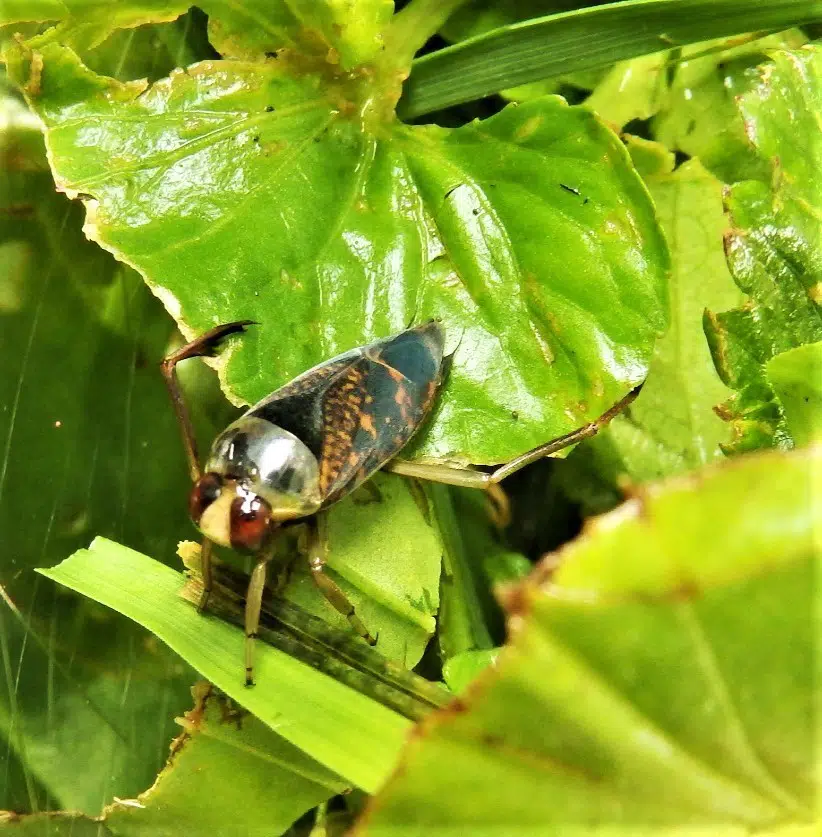
This species of water bug is small compared to the average US alternative. It grows up to 15mm and it can be identified by the spots on its body.
Water bugs of the species are black with brown spots and large brown eyes. They have black legs adapted to aquatic and terrestrial use.
Bugs of the species are found in lakes and ponds. On occasion when food isn’t readily available, bugs of the species will also move to slow-moving streams.
9. Lethocerus medius

Bugs of the species are common in lakes and ponds. The Lethocerus medius grows up to 2 inches. It uses its front legs as pincers that grab onto prey and its mid-legs for swimming.
These bugs can live on water and just above the surface of the water. However, these need to be water with overhanging vegetation as the bugs use this vegetation to get their abdomens out to breathe from time to time.
Innate patience is characteristic of the species. These bugs await prey along the water.
Lethocerus medius feeds both on vertebrates and on invertebrates. The species is among the water bugs that also eat vertebrates. This includes vertebrates that prefer high humidity habitats such as salamanders.
10. Abedus indentatus

These water bugs are seen exclusively just under the surface level in small streams. They have a spotted green body color and they are almost motionless during the day.
Bugs of the species attach themselves to various objects in water which prevents them from moving away from the current. This includes rocks and driftwood.
They start to emerge in the spring when females are seen carrying eggs attached to the body.
Like most types of water bugs, Abedus indentatus is a species that preys on tadpoles and all types of insects that live in the water.
They practice awaiting techniques where prey has to come to them.
These water bugs are both diurnal and nocturnal. Flying at night, the water bugs prefer to be truly physically active when they can’t easily be seen by predators such as birds.
11. Saucer Bug

Saucer Bugs (Ilyocoris cimicoides) grow up to 1 inch. They are identified by their yellow body with brown-black marks.
These bugs spend most of their lives in the water. They know how to hold breath while diving and they do this primarily in search of food such as water insects.
Common throughout the year, Saucer bugs have adapted legs that act as pincers to grab prey.
While they hold prey with these pincer-like legs, Saucer bugs insert saliva with enzymes into prey which.
This liquefies the inner parts of the prey and allows the bugs to suck the content for nutrients.
12. Greater Water Boatman

Greater Water Boatman (Notonecta glauca) grow up to 13mm in the case of males and up to 16mm in the case of males.
These water bugs are primarily known for their ability to float on water, which inspires their name.
Characterized by a brown color, the bugs are seen on top of water almost all day long.
Their bodies are covered in hairs which are responsible for creating an air bubble around the body. This air retention capacity is what keeps the bug afloat.
Females of the species have further developed diving skills. They only dive in shallow water where they can see a type of prey worth diving for.
Female Greater Water Boatman are often seen diving for Asellus larvae.
13. Kirby’s Backswimmer
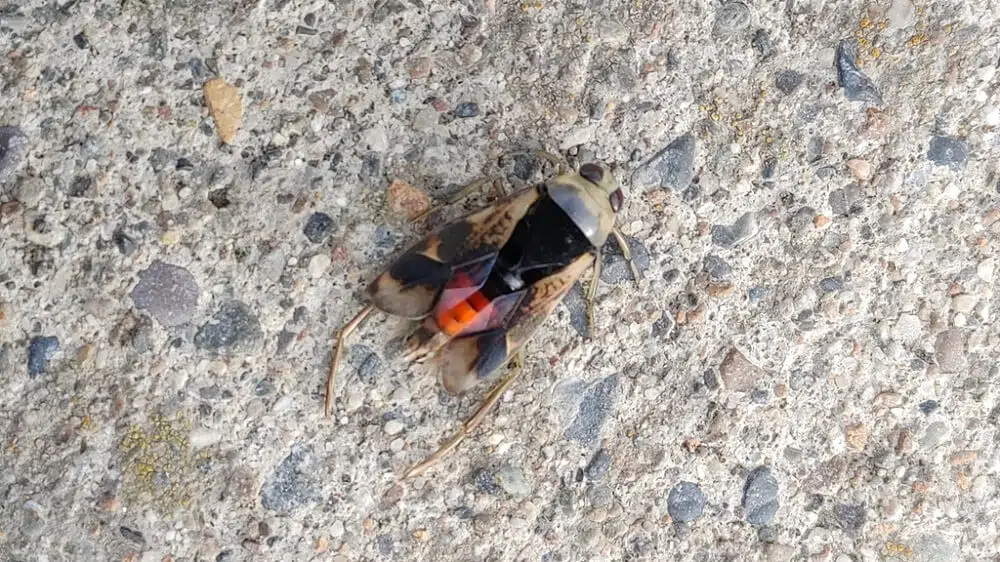
Part of the Notonectidae family, this species of water bug (Notonecta kirbyi) is common across North America.
It has a tricolored body, unlikely in the world of water bugs.
They have mustard-yellow legs and a black body with red markings. The upper thorax of the species is also of the same yellow-mustard color as the legs.
14. Laccotrephes tristis
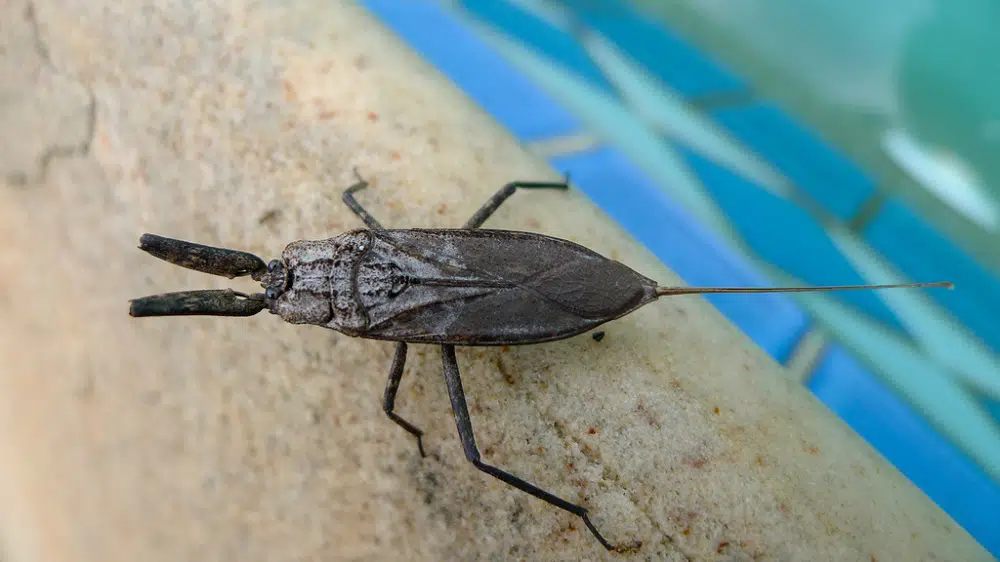
Bugs of this species are common in the US. They have a flattened body which is either rusty brown or brown.
Preferred habitat includes lakes, ponds, and streams. Water bugs of this species are seen floating on water where they are normally attached to objects and awaiting prey.
Over 60 species of Laccotrephes tristis exist around the world. All of them have pincer-like legs used against prey.
The bugs can also go below the water surface by using the extensions from their abdomens that look like filaments. These act as air pipes providing a constant flow of air even when the bugs have to remain below the surface level of the water for a longer time.
15. Asian Giant Water Bug

This water bug (Lethocerus indicus) is very common in parts of Southeast Asia. It’s recognized by its almost all-black body with thick legs adapted for water preying.
The bug uses 2 of its legs as paddles to manage to move on the water better. It also uses its front legs as pincers.
Males of these species have been shown to use pheromones to attract females for mating. They emit a banana-like smell to attract female Asian Giant Water Bugs.
However, the Asian Giant Water Bug is considered a tasty treat in countries such as Thailand where it’s part of the traditional cosine.
16. Pelocoris femoratus
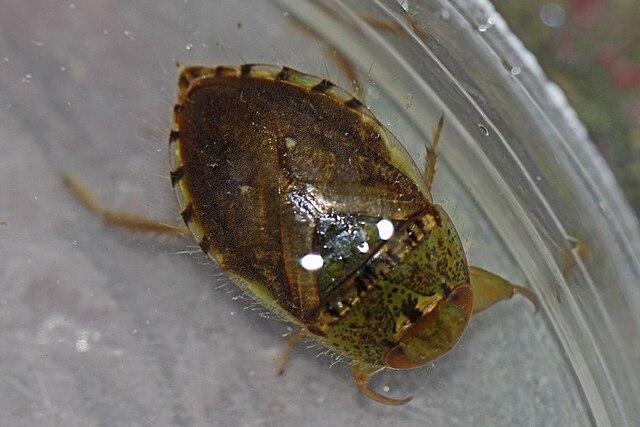
This species of water bug is native to North America, Central America, and South America.
It has a distinct body in terms of coloration which sometimes acts in its benefit as camouflage.
Pelocoris femoratus are bugs that have a dark brown body with yellow margins. These bugs have light brown marks across the body.
The species has been studied extensively, especially for its ability to dive. Bugs of this species take a long breath of air retaining an air bubble used for oxygen when diving.
They come up to the surface whenever this air bubble reserve is low.
Buts of the species have also been shown to be more active at night. They prefer to move along slow-moving streams at night.
This can be a self-defense technique as predators such as birds and fish don’t see them at night.
17. African Giant Water Bug
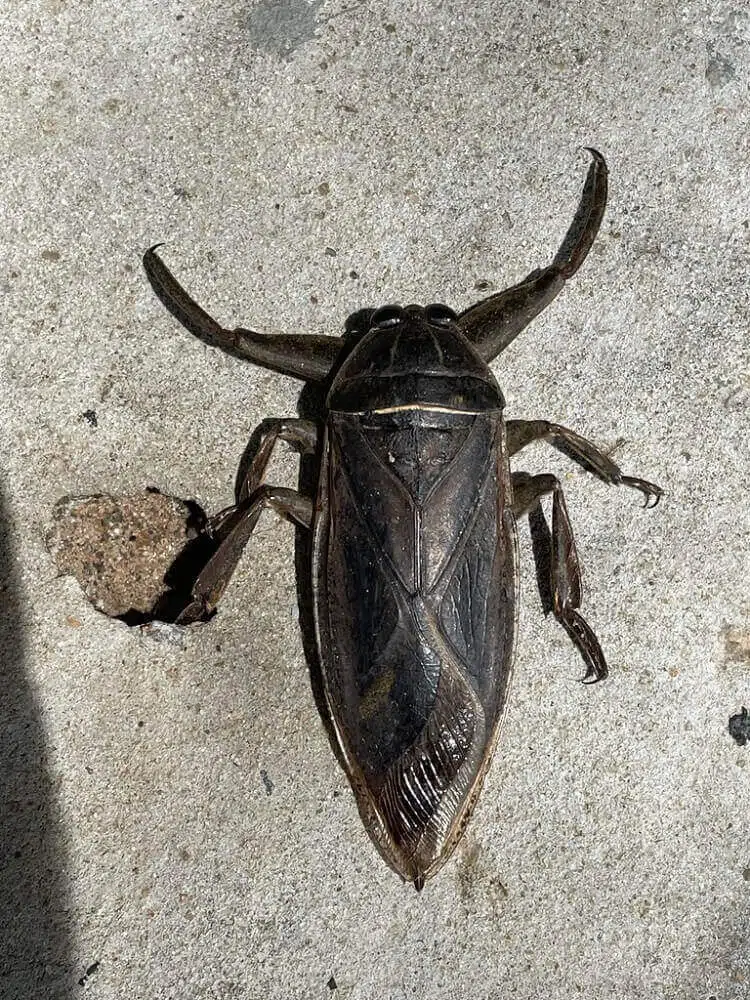
The African Giant Water Bug (Lethocerus cordofanus) is a related species to the Giant Water Bug. This species is known for its very large dark-brown to black body.
African Giant Water Bugs grow anywhere between 1.8 and 3.5 inches. They are adapted to living around water and especially above water.
Females always lay eggs on vegetation above the water. This is done so that the eggs are never subject to flooding accidents as eggs need to hatch outside water.
Other species of water bugs lay eggs on males but the females of the species lay eggs on vegetation early in the season.
Both male and female African Giant Water bugs can sting prey. Once stung, prey suffers from anesthetic-like saliva inserted into the body.
18. Grousewinged Backswimmer
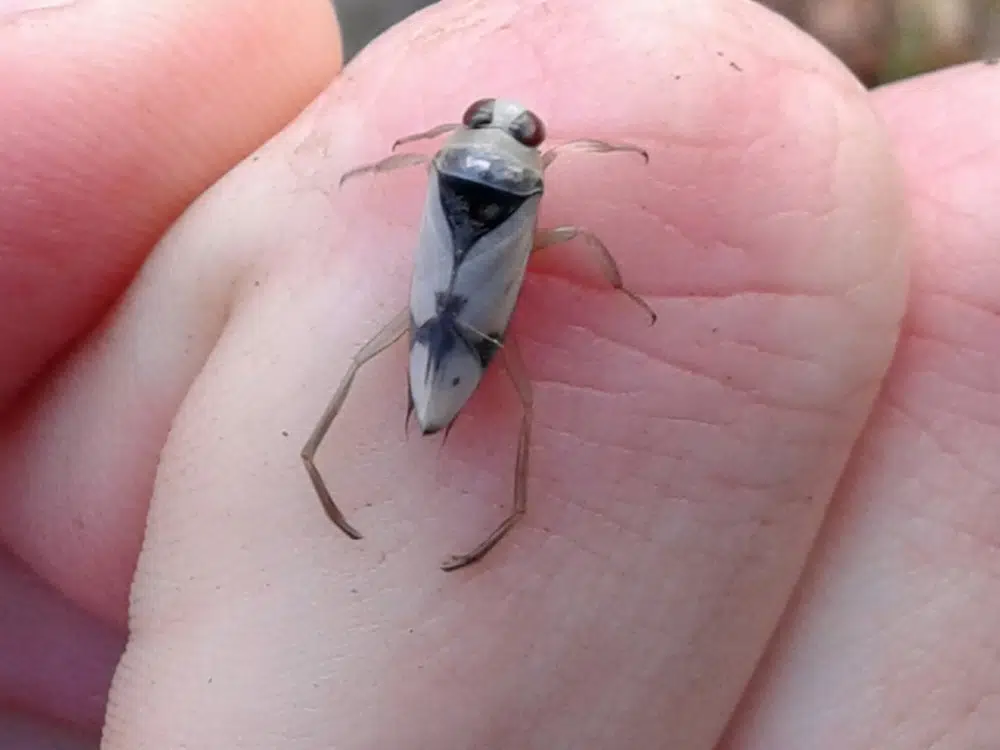
The Grousewinged Backswimmer (Notonecta undulata) is a species of beneficial water bugs as they have a mild biological control role. These bugs feed on some mosquitoes that spread malaria.
Bugs of this species feed on a wider range of animals and insects, both aquatic and terrestrial. However, for them to feed on terrestrial insects these insects need to fall on the water.
Bugs of the genus prefer to live in ponds and streams. They often fly to search for a better habitat with more food, more vegetation, and fewer chances of meeting predators.
They also look for prey such as crustaceans and fish eggs.
19. Lesser Water-Boatman

This common water bug (Corixa punctata) grows to a size of 0.5 to 0.7 inches. It has a black body with yellow lines and yellow markings.
The Lesser Water-Boatman is one of the herbivorous water bugs. It doesn’t eat any insects or animals as it feeds on algae.
Lesser Water-Boatman bugs have also adapted their breathing techniques so that they can swim with their head in the water.
For this, the first flip so that they swim with their legs up. This allows them to breathe through abdomen adaptations.
20. Australian-Asian Giant Water Bug
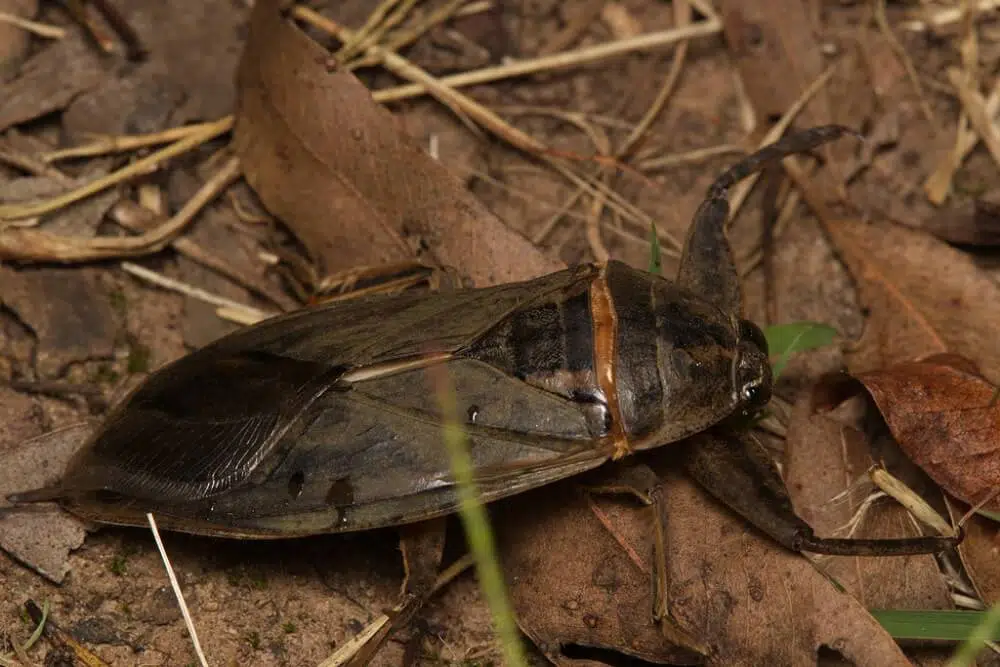
Some bugs (Lethocerus insulanus) are only found in certain areas of the world. The Australia-Asian Giant Water Bug is mostly found around Northern Australia and Queensland.
This is a species of large amber-brown water bugs that prefers still water habitats.
Bugs of this species grow to a size between 2 and 2.8 inches as adults.
Australian-Asian bugs have adapted snorkel-like breathing systems that allow them to breathe while swimming just below the water surface level.
21. Madagascan Giant Water Bug

This type of bug (Lethocerus oculatus) is part of the Lethocerus genus. It’s part of a limited number of Lethocerus water bugs found across the world.
A few Lethocerus members are seen in Asia, a couple in Africa, and just a few others in Asia and Europe.
Like all Lethocerus bugs, the Madagascan Giant Water Bug remains one of the largest water bugs, regularly growing to a size of more than 2 inches.
Bugs of the species have a brown body color with light brown undertones.
The Madagascan Giant Water Bug has complex mating habits. It prefers environments with sufficient overhanging vegetation.
This vegetation is used for the females of the species to lay eggs on.
22. Great Waterbug
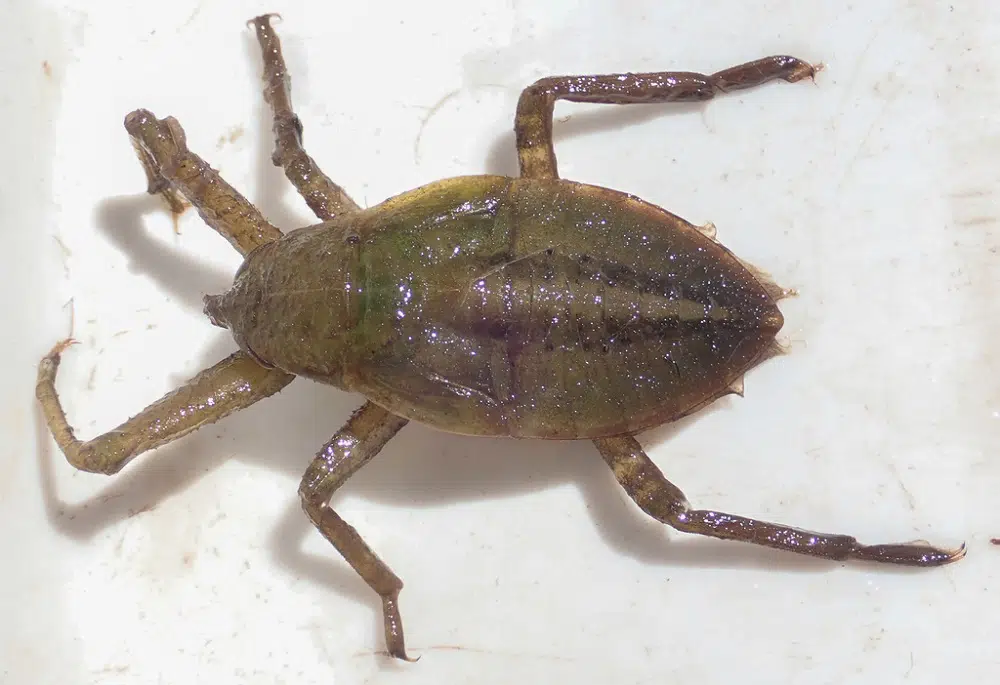
This species of water bug (Hydrocyrius columbiae) can bite. It has a large body as it regularly grows up to 3 inches.
Its front legs often act as pincers.
The bugs are identified by a mostly black body with dark yellow stripes and marks. 2 long yellow stripes run across its body from head to abdomen.
23. Needle Bug
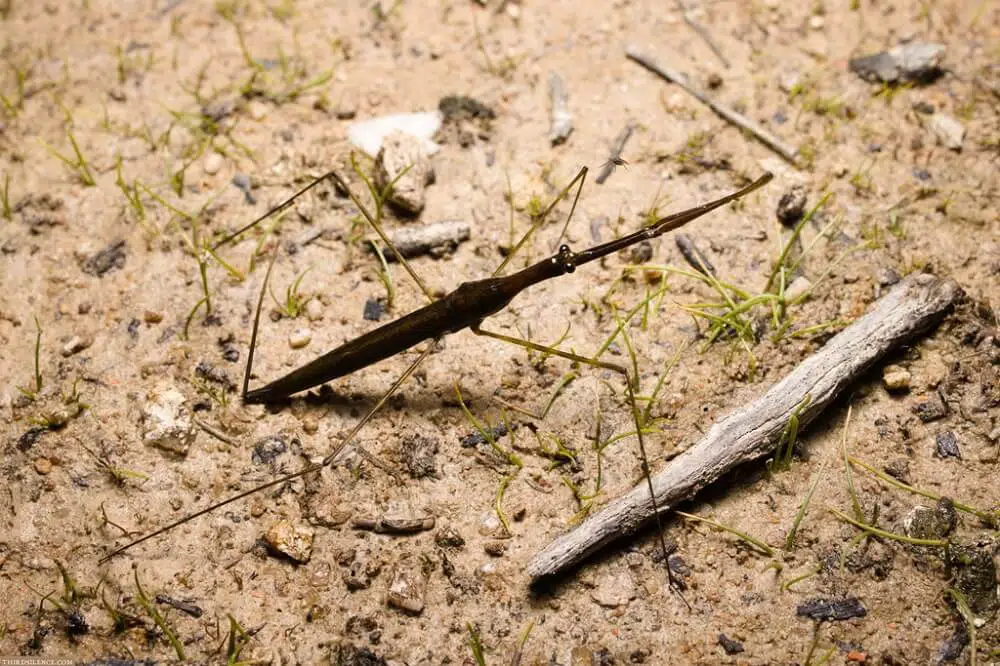
Needle Bugs (Ranatra dispar) get their names from their thin elongated body and extra-long legs.
These water bugs are known to have a black body and black legs. Like other Ranatra genus water bugs, Needle Bugs are known for staying motionless on the water surface throughout the day.
They expect their prey to come into their reach before making a move.
Some Needle bugs are almost impossible to detect when they sit motionless on vegetation above the water.
24. Indo-East Mediterranean Giant Water Bug
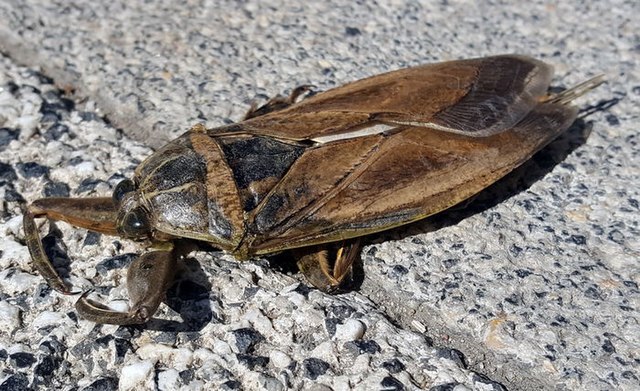
This species of water bug (Lethocerus patruelis) is one of the largest in the world. Males and females of the species can grow up to 5 inches.
Indo-Easter Mediterranean Giant Water Bugs are common in Southern Europe across Greece and neighboring countries as well as in Asia.
These water bugs are known to have an adapted first pair of legs that acts similar to pincers and that makes them resemble scorpions.
Identified by their brown body, these water bugs can fly. They do this mostly by seeking other sandy habitats or streams where they can eat aquatic arthropods and even small fish.
These water bugs are also seen in tall grass habitats near water which makes some people believe they lay eggs further away from water compared to other water bugs.
Further Reading: